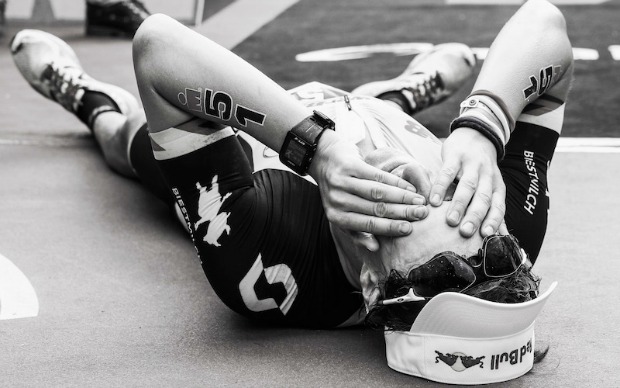
Let's face it, at some point during your race you're going to hurt. I don't mean that random knee pain that pops up now and then, or the side cramp that comes and goes, I mean that suffering that comes when you're mentally tired and physically fatigued. But, you have a goal so you will yourself to push through it anyway. THAT kind of hurt, and your ability to push through that hurt in order to achieve your goal is going to come down to how well you can suffer. So—how can you train to suffer better?
Well, just like training in general, in order to suffer better you're going to have to practice suffering. I know, that's probably the last thing you wanted to hear, but it will work, and you'll thank me for it later. You're welcome.
The logical question, then is: how do you practice suffering? You start by suffering for just a little bit at a time during your workouts—even just three or four bouts of 30 seconds of real suffering within a 30 to 60 minute workout. Then you extend that to six or eight rounds of a minute or two of suffering, and you suffer a little more during those minutes than you did during the shorter intervals. So you're increasing not only how long you can suffer, but also the level of suffering you can put up with.
You'll go on with that kind of training for a bit, and then about halfway through your season you're going to switch it up. You'll start really lengthening those bouts of suffering, but you won't make the suffer-fest quite as intense. It won't hurt as much, but it will definitely hurt longer.
At this point you've probably put two and two together and realized that what I'm describing sounds—at least initially—a lot like high intensity interval training (HIT). And that transitioning from HIT to endurance training sounds a lot like Reverse Periodization (see Coach AJ's article from last month). So am I really teaching you how to train to suffer better, or am I teaching you incorporate HIT early into your training season to achieve better results?
I'm doing both. HIT training has some incredible benefits for your fitness:
- It improves your utilization of carbohydrates as fuel.
- It increases muscle fiber recruitment and muscular capacity, and decreases the amount of lactate that is produced at a given effort level. This translates to an increased Lactate Threshold level, but also an improved aerobic capacity.
- Taking all the exercise science speak out of it: you will be able to go faster longer and with less effort.
But we started by talking about suffering, so let's get back to that. HIT training, while having all these fabulous physiological benefits, also helps you recalibrate how you perceive suffering. By repeatedly throwing yourself down your suffer well, you will realize that your well is deeper than you originally thought it was. What seemed crazy painful in week one is magically easier to tolerate by week eight. And if you know you can put up with serious suffering for two minutes, it's not as daunting to put up with a lower level of suffering for ten.
By now I've hopefully convinced you that HIT is where it's at, but why start HIT early? Why can't you defer throwing yourself down the suffer well until the last minute? Glad you asked. First off, you want to get those fitness benefits from HIT right out of the gate so that you can continue to build on them throughout your training season. From a suffering standpoint, though, what you ultimately care about is how well you suffer at race pace—and that's not what HIT is going to teach you. You need to start with HIT to recalibrate your high end for suffering early in the season, but then use the second half of your season to stretch that out and learn how to suffer better at race pace.
You want time to practice long stretches of just-faster-than-race-pace suffering so that you know—you teach yourself—how long you can tolerate it. Because then, when you're two miles from the finish and the fatigue has set in and part of you thinks you are done, you can remember your goal and remember how deep your suffer well runs and know that you actually CAN put up with that suffering for two more measly miles because you did it for four in training.
That, my friends, is how you learn to suffer better!
Coach Alison Freeman believes that when it comes to triathlon, it's really important to look for a win everywhere. Committing to taking on a new race distance? Stretching yourself to tackle tough workouts? Sticking with a six to nine month training plan? They are all wins! And when you work around obstacles that life throws in your path, and you still make it to the starting line of a race? THAT is a really big win!

